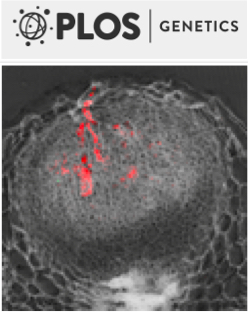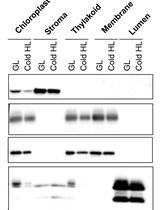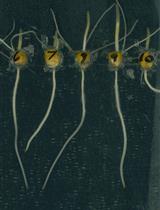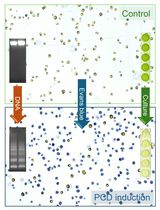- EN - English
- CN - 中文
Cotyledon Wounding of Arabidopsis Seedlings
拟南芥幼苗的子叶创伤
发布: 2016年01月20日第6卷第2期 DOI: 10.21769/BioProtoc.1712 浏览次数: 12837
评审: Arsalan DaudiKaisa KajalaAnonymous reviewer(s)
Abstract
Damage to plant organs through both biotic and abiotic injury is very common in nature. Arabidopsis thaliana 5-day-old (5-do) seedlings represent an excellent system in which to study plant responses to mechanical wounding, both at the site of the damage and in distal unharmed tissues. Seedlings of wild type, transgenic or mutant lines subjected to single or repetitive cotyledon wounding can be used to quantify morphological alterations (e.g., root length, Gasperini et al., 2015), analyze the dynamics of reporter genes in vivo (Larrieu et al., 2015; Gasperini et al., 2015), follow transcriptional changes by quantitative RT-PCR (Acosta et al., 2013; Gasperini et al., 2015) or examine additional aspects of the wound response with a plethora of downstream procedures. Here we illustrate how to rapidly and reliably wound cotyledons of young seedlings, and show the behavior of two promoters driving the expression of β-glucuronidase (GUS) in entire seedlings and in the primary root meristem, following single or repetitive cotyledon wounding respectively. We describe two procedures that can be easily adapted to specific experimental needs.
Keywords: Plant (植物)Materials and Reagents
- Single wounding of seedling cotyledons
- Sterile 6 cm x 6 cm nylon mesh, 200 μm pore size (Lanz-Anliker AG, custom made)
- Standard 9 cm round Petri plates
- 3MTM MicroporeTM Tape, 1.25 cm x 9.14 m, hypoallergenic tape, standard roll (3M, catalog number: 1530-0 )
- Two 25 G x 5/8” hypodermic needles, 0.5 mm x 16 mm (BD Bioscience, catalog number: 305760 )
- Arabidopsis thaliana sterile seeds, e.g., MYC2p-GUS reporter line (Gasperini et al., 2015)
- Sterile double distilled H2O (ddH2O)
- Murashige and Skoog (MS) medium (Duchefa Biochemie, catalog number: M0221.0050 )
- MES hydrate (Sigma-Aldrich, catalog number: M8250 )
- Agar (AppliChem GmbH, catalog number: A2111 1000 )
- Standard 9 cm round Petri plates filled with 30 ml of solid half-strength Murashige and Skoog (0.5x MS) medium with 0.7% agar (see Recipes)
- Sterile 6 cm x 6 cm nylon mesh, 200 μm pore size (Lanz-Anliker AG, custom made)
- Repetitive wounding of seedling cotyledons
- 3MTM MicroporeTM Tape, 2.5 cm x 9.14 m, hypoallergenic tape, standard roll (3M, catalog number: 1530-1 )
- One 25 G x 5/8” hypodermic needle, 0.5 mm x 16 mm (BD Bioscience, catalog number: 305760 )
- One 36 gauge beveled NanoFil needle, 110 µM outer diameter (World Precision Instruments, catalog number: NF36BV )
- Standard 12 cm x 12 cm square Petri plates
- Racks for vertical growth (e.g., Milian, catalog number: 086680 )
- Arabidopsis thaliana sterile seeds, e.g., CYCB1;1p-GUS reporter line (Colón-Carmona et al., 1999)
- Sterile ddH2O
- Standard 12 cm x 12 cm square Petri plates filled with 70 ml 0.5x MS with 0.85% agar (see Recipes)
- 3MTM MicroporeTM Tape, 2.5 cm x 9.14 m, hypoallergenic tape, standard roll (3M, catalog number: 1530-1 )
- GUS staining
- Staining dish [e.g., 12 well suspension culture plate (Greiner Bio-One GmbH, Cell Star®, catalog number: 665102 )]
- Ice bucket with ice
- Microscopy slides (e.g., Thermo Fisher Scientific, Menzel-Glaser,catalog number: AD00000112E ) and coverslips (e.g., Thermo Fisher Scientific, Menzel-Glaser, catalog number: BB024060A1 )
- 90% (v/v) acetone in ddH2O
- 50 mM sodium phosphate buffer (pH 7.0)
- 70% (v/v) ethanol (EtOH) in ddH2O
- Potassium Ferrocyanide [e.g., Potassium hexacyanoferrate(II) trihydrate (Sigma-Aldrich, catalog number: 60279 )]
- Potassium Ferricyanide [e.g., Potassium hexacyanoferrate(III) (Merck Millipore Corporation, catalog number: 104973 )]
- 5-Bromo-4-chloro-3-indoxyl-beta-D-glucuronic acid (X-Gluc) (e.g., Biosynth, catalog number: B-7300 )
- Chloral hydrate (e.g., Sigma-Aldrich, catalog number: 23100 )
Safety note: acute toxicity, avoid inhalation. - Glycerol (e.g., Sigma-Aldrich, catalog number: G6279 )
- GUS staining solution (see Recipes)
- Chloride hydrate solution (see Recipes)
- Staining dish [e.g., 12 well suspension culture plate (Greiner Bio-One GmbH, Cell Star®, catalog number: 665102 )]
Equipment
- Sterile hood (laminar flow hood)
- Fine forceps style 4 (e.g., Dumont, catalog number: 0508-4-PO )
- Micropipettes (P20, P200, P1000)
- Phytotron or plant growth chamber set with the following growth conditions: 21 °C, 100 μE m-2 s-1 light intensity, 14 h light/ 10 h dark photoperiod
- Portable dissecting stereomicroscope
- Vacuum pump
- 37 °C incubator
- Stereomicroscope [e.g., Leica Microsystems, model: Leica MZ16A fitted with a camera (model: DFC310FX )]
- Differential Interference Contrast (DIC) microscope [e.g., Leica Microsystems, model: Leica DM5500 fitted with a camera (model: DFC420 )]
Procedure
文章信息
版权信息
© 2016 The Authors; exclusive licensee Bio-protocol LLC.
如何引用
Gasperini, D., Acosta, I. F. and Farmer, E. E. (2016). Cotyledon Wounding of Arabidopsis Seedlings. Bio-protocol 6(2): e1712. DOI: 10.21769/BioProtoc.1712.
分类
植物科学 > 植物生理学 > 非生物胁迫
植物科学 > 植物生理学 > 组织分析
植物科学 > 植物免疫 > 信号感知与传递
您对这篇实验方法有问题吗?
在此处发布您的问题,我们将邀请本文作者来回答。同时,我们会将您的问题发布到Bio-protocol Exchange,以便寻求社区成员的帮助。
Share
Bluesky
X
Copy link













